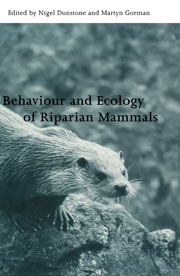Book contents
- Frontmatter
- Contents
- List of contributors
- Preface
- 1 Adaptations to the semi-aquatic habit and habitat
- 2 Physiological challenges in semi-aquatic mammals: swimming against the energetic tide
- 3 Diving capacity and foraging behaviour of the water shrew (Neomys fodiens)
- 4 Habitat use by water shrews, the smallest of amphibious mammals
- 5 The importance of the riparian environment as a habitat for British bats
- 6 A preliminary study of the behaviour of the European mink Mustela lutreola in Spain, by means of radiotracking
- 7 The demography of European otters Lutra lutra
- 8 Habitat use and conservation of otters (Lutra lutra) in Britain: a review
- 9 The relationship between riverbank habitat and prey availability and the distribution of otter (Lutra lutra) signs: an analysis using a geographical information system
- 10 Influence of altitude on the distribution, abundance and ecology of the otter (Lutra lutra)
- 11 Diets of semi-aquatic carnivores in northern Belarus, with implications for population changes
- 12 Otter (Lutra lutra) prey selection in relation to fish abundance and community structure in two different freshwater habitats
- 13 Diet, foraging behaviour and coexistence of African otters and the water mongoose
- 14 Feeding ecology of the smooth-coated otter Lutra perspicillata in the National Chambal Sanctuary, India
- 15 Population trends of hippopotami in the rivers of the Kruger National Park, South Africa
- 16 Reproductive strategies of female capybaras: dry-season gestation
- 17 The continuing decline of the European mink Mustela lutreola: evidence for the intraguild aggression hypothesis
- 18 Otters and pollution in Spain
- 19 The rapid impact of resident American mink on water voles: case studies in lowland England
- 20 Status, habitat use and conservation of giant otter in Peru
- Index
14 - Feeding ecology of the smooth-coated otter Lutra perspicillata in the National Chambal Sanctuary, India
Published online by Cambridge University Press: 03 May 2010
- Frontmatter
- Contents
- List of contributors
- Preface
- 1 Adaptations to the semi-aquatic habit and habitat
- 2 Physiological challenges in semi-aquatic mammals: swimming against the energetic tide
- 3 Diving capacity and foraging behaviour of the water shrew (Neomys fodiens)
- 4 Habitat use by water shrews, the smallest of amphibious mammals
- 5 The importance of the riparian environment as a habitat for British bats
- 6 A preliminary study of the behaviour of the European mink Mustela lutreola in Spain, by means of radiotracking
- 7 The demography of European otters Lutra lutra
- 8 Habitat use and conservation of otters (Lutra lutra) in Britain: a review
- 9 The relationship between riverbank habitat and prey availability and the distribution of otter (Lutra lutra) signs: an analysis using a geographical information system
- 10 Influence of altitude on the distribution, abundance and ecology of the otter (Lutra lutra)
- 11 Diets of semi-aquatic carnivores in northern Belarus, with implications for population changes
- 12 Otter (Lutra lutra) prey selection in relation to fish abundance and community structure in two different freshwater habitats
- 13 Diet, foraging behaviour and coexistence of African otters and the water mongoose
- 14 Feeding ecology of the smooth-coated otter Lutra perspicillata in the National Chambal Sanctuary, India
- 15 Population trends of hippopotami in the rivers of the Kruger National Park, South Africa
- 16 Reproductive strategies of female capybaras: dry-season gestation
- 17 The continuing decline of the European mink Mustela lutreola: evidence for the intraguild aggression hypothesis
- 18 Otters and pollution in Spain
- 19 The rapid impact of resident American mink on water voles: case studies in lowland England
- 20 Status, habitat use and conservation of giant otter in Peru
- Index
Summary
Introduction
Three species of otter occur in the Indian sub–continent: the Eurasian otter, Lutra lutra Linnaeus, the smooth–coated otter, L. perspicillata Geoffroy, and the original small–clawed otter, Aonyx cinerea Illegar. The smooth–coated otter is distributed throughout the Indian sub–continent, from the Himalayas southward. Outside the Indian sub–continent, its range extends to Mynamar, Indonesia, Kampuchea, Laos People's Republic, Malaysia, Vietnam, southwestern China and Brunei, with an isolated race, L perspicillata maxwelli, in the marshes of southern Iraq (Pocock, 1941: 265–312; Prater, 1971; Mason & Macdonald, 1986). Despite its wide distribution, no detailed ecological studies on this species have been undertaken so far. It is listed as insufficiently known in the IUCN red data book (Groombridge, 1994) and is protected under Schedule II of the Indian Wildlife (Protection) Act, 1972. Previous work on Indian otters involved observations on captive animals (Desai, 1974; Acharjyo & Mishra, 1984) with occasional notes on their occurrence from different parts of the country (e.g. Hinton & Fry, 1923; Pocock, 1939; Chitampalli, 1979) and a few studies on their feeding habits (e.g. Wayre, 1978; Foster–Turley, 1992; Kruuk et al 1994).
It is believed that the existing populations of all the three Indian species are rapidly declining due to loss of habitat and intensive trapping (Hussain & Choudhury, 1997). Because of limited knowledge on the ecology of Oriental otter species, practical conservation measures are difficult to develop.
- Type
- Chapter
- Information
- Behaviour and Ecology of Riparian Mammals , pp. 229 - 250Publisher: Cambridge University PressPrint publication year: 1998
- 2
- Cited by



